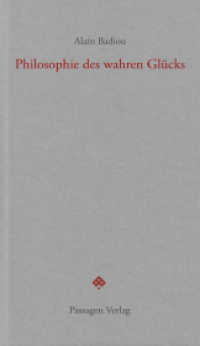Full Description
There is something special about a studio as a place of practice and learning.
Studio is a complex form of teaching and learning. If you have not experienced studio, it may seem mysterious, even chaotic. If you have experienced studio, you may want to know more about how and why it works. Either way, Studio Properties will deepen your understanding of studio to help you teach, research, or administer design education more effectively and with greater confidence and creativity.
Use Studio Properties like a field guide. You will discover the components of studio broken down into individual properties. You will find clear descriptions and a wealth of research references that illuminate studio. You will be guided in understanding the relationships between properties without being limited to one model or approach.
In this innovative and non-linear book, available in print, ebook and open access, six internationally renowned and award-winning educators and researchers from various studio disciplines invite you to explore familiar and less-familiar aspects of studio.
The ebook editions of this book are available open access under a CC BY-NC-ND 4.0 licence on bloomsburycollections.com. Open access was funded by the Open University.
Contents
Introduction
Part 1 The Properties
Visibilities and Proximities
1. Making Visible
2. Extended and Distributed Cognition
3. Informal Learning Spaces
4. No Front
5. Surfaces
6. Cost
7. Public and Private Spaces
Foundations and Methods
8. Apprenticeship
9. Design Brief
10. Active Teaching
11. Feedback
12. Critique and the Crit
13. Reflection
Expertise and Identity
14. Expertise
15. Identities
16. Judgement
17. Character
18. Journey
19. Performance
20. Transformative Pedagogy
Time and Structures
21. Immersion
22. Time
23. Rhythms
24. Synchronicity and Proximity
25. Project Cycles
Artefacts and Making
26. Materiality
27. Learning by Doing
28. Making
29. Artefacts
30. Play
31. Prototyping
Interactions and Sociality
32. Learning and Designing Collectively
33. Listening-in
34. Social Comparison
35. Confidence to Speak
36. Dialogue
37. Social Networks
38. Belonging
Atmospheres and Place
39. Place
40. Affect
41. Informalities
42. Uncertainty and Ambiguity
43. Serendipity
44. Wellbeing
Theories and Knowledge
45. Creativity
46. Risk and Failure
47. Simulation
48. Assessment
49. Discipline
50. General Education
51. Concepts and Theories
52. Knowledge and Knowing
Culture(s) and Power
53. Habits and Rituals
54. Habitus
55. Hidden Curriculum
56. Critical Pedagogy
57. Power Transaction
58. Enculturation, Acculturation, and Indoctrination
Part 2 Narratives
1. Albert and Laura plan to team teach in studio
2. Zoe teaches a hybrid studio
References
Index








